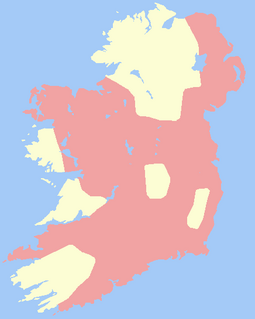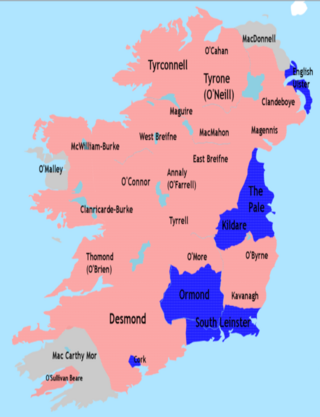 W
WThe Irish Rebellion of 1798 was a major uprising against British rule in Ireland. The main organising force was the Society of United Irishmen, a republican revolutionary group influenced by the ideas of the American and French revolutions: originally formed by Presbyterian radicals angry at being shut out of power by the Anglican establishment, they were joined by many from the majority Catholic population.
 W
WThe Irish Republic of 1798, more commonly known as the Republic of Connacht, was a short-lived state proclaimed during the Irish Rebellion of 1798 that resulted from the French Revolutionary Wars. A client state of the French Republic, it theoretically covered the whole island of Ireland, but its functional control was limited to only very small parts of the Province of Connacht. Opposing British forces were deployed across most of the country including the main towns such as Dublin, Belfast and Cork.
 W
WThe Battle of Glenn Máma or Glenmama took place most probably near Lyons Hill in Ardclough, County Kildare in AD 999 between Windmill Hill and Blackchurch. It was the decisive and only engagement of the brief Leinster revolt of 999–1000 against the King of Munster, Brian Boru. In it, the combined forces of the Kingdoms of Munster and Meath, under King Brian Boru and the High King of Ireland, Máel Sechnaill II, inflicted a crushing defeat on the allied armies of Leinster and Dublin, led by King Máel Mórda of Leinster.
 W
WThe Bruce campaign was a three-year military campaign in Ireland by Edward Bruce, brother of the Scottish king Robert the Bruce. It lasted from his landing at Larne in 1315 to his defeat and death in 1318 at the Battle of Faughart in County Louth. It was part of the First War of Scottish Independence and the conflict between the Irish, Scoto-Normans, and the Hiberno-Normans.
 W
WThe Desmond Rebellions occurred in 1569–1573 and 1579–1583 in the Irish province of Munster.
 W
WThe Easter Rising, also known as the Easter Rebellion, was an armed insurrection in Ireland during Easter Week in April 1916. The Rising was launched by Irish republicans against British rule in Ireland with the aim of establishing an independent Irish Republic while the United Kingdom was fighting the First World War. It was the most significant uprising in Ireland since the rebellion of 1798 and the first armed conflict of the Irish revolutionary period. Sixteen of the Rising's leaders were executed from May 1916, but the insurrection, the nature of the executions, and subsequent political developments ultimately contributed to an increase in popular support for Irish independence.
 W
WThe Irish Republican Brotherhood (IRB) organised the Fenian Rising of 1867 as a rebellion against British rule in Ireland.
 W
WThe Irish rebellion of 1803 was an unsuccessful violent attempt by a small group of Irish republicans and Irish nationalists to secure Ireland's independence as an independent secular republic from Great Britain.
 W
WThe Irish Republican Brotherhood was a secret oath-bound fraternal organisation dedicated to the establishment of an "independent democratic republic" in Ireland between 1858 and 1924. Its counterpart in the United States of America was initially the Fenian Brotherhood, but from the 1870s it was Clan na Gael. The members of both wings of the movement are often referred to as "Fenians". The IRB played an important role in the history of Ireland, as the chief advocate of republicanism during the campaign for Ireland's independence from the United Kingdom, successor to movements such as the United Irishmen of the 1790s and the Young Irelanders of the 1840s.
 W
WThe Irish Volunteers, sometimes called the Irish Volunteer Force or Irish Volunteer Army, was a military organisation established in 1913 by Irish nationalists. It was ostensibly formed in response to the formation of the Ulster Volunteers in 1912, and its declared primary aim was "to secure and maintain the rights and liberties common to the whole people of Ireland". The Volunteers included members of the Gaelic League, Ancient Order of Hibernians and Sinn Féin, and, secretly, the Irish Republican Brotherhood (IRB). Increasing rapidly to a strength of nearly 200,000 by mid-1914, it split in September of that year over John Redmond's commitment to the British War effort, with the smaller group retaining the name of "Irish Volunteers".
 W
WThe Irish War of Independence or Anglo-Irish War was a guerrilla war fought in Ireland from 1919 to 1921 between the Irish Republican Army and British forces: the British Army, along with the quasi-military Royal Irish Constabulary (RIC) and its paramilitary forces the Auxiliaries and Ulster Special Constabulary (USC). It was part of the Irish revolutionary period.
 W
WThomas FitzGerald, 10th Earl of Kildare, also known as Silken Thomas, was a leading figure in 16th-century Irish history.
 W
WThis article is a list of the participants, both civilian and military, of the Nine Years' War in Ireland. The war was fought in the late 16th and early 17th century and was a conflict between a coalition of Irish lords and their Spanish allies against the English and their authorities in Ireland.In order to be listed here an individual must have a historical record of their conduct, position or any role they played in the war during the years 1593-1603.
 W
WThe military history of Ireland comprises thousands of years of armed actions in the territory encompassing the island of Ireland.
 W
WThe Nine Years' War, sometimes called Tyrone's Rebellion, took place in Ireland from 1593 to 1603. It was fought between an Irish alliance—led mainly by Hugh O'Neill of Tyrone and Hugh Roe O'Donnell of Tyrconnell—against English rule in Ireland, and was a response to the then-ongoing Tudor conquest of Ireland. The war was fought in all parts of the country, but mainly in the northern province of Ulster. The Irish alliance won some important early victories, such as the Battle of Clontibret (1595) and the Battle of the Yellow Ford (1598), but the English won a decisive victory against the alliance and their Spanish allies in the siege of Kinsale (1601–02). The war ended with the Treaty of Mellifont (1603). Many of the defeated northern lords left Ireland to seek support for a new uprising in the Flight of the Earls (1607), never to return. This marked the end of Gaelic Ireland and led to the Plantation of Ulster.
 W
WO'Doherty's rebellion took place in 1608 when Sir Cahir Rua O'Doherty, Lord of Inishowen, began an uprising against the Crown authorities in the west of Ulster in the north-west of the Kingdom of Ireland. O'Doherty, a Gaelic chieftain, had been a long-standing supporter of the Crown, but having been angered at his treatment by local officials he launched an attack on Derry, burning the town. O'Doherty may have hoped to negotiate a settlement with the government, but, after his death in a skirmish at Kilmacrennan, the rebellion collapsed with the last survivors being besieged on Tory Island.
 W
WRibbonism, whose supporters were usually called Ribbonmen, was a 19th-century popular movement of poor Catholics in Ireland. The movement was also known as Ribandism. The Ribbonmen were active against landlords and their agents, and opposed "Orangeism", the ideology of the Protestant Orange Order.
 W
WThe Young Irelander Rebellion was a failed Irish nationalist uprising led by the Young Ireland movement, part of the wider Revolutions of 1848 that affected most of Europe. It took place on 29 July 1848 at Farranrory, a small settlement about 4.3 km north-northeast of the village of Ballingarry, South Tipperary. After being chased by a force of Young Irelanders and their supporters, an Irish Constabulary unit took refuge in a house and held those inside as hostages. A several-hour gunfight followed, but the rebels fled after a large group of police reinforcements arrived.